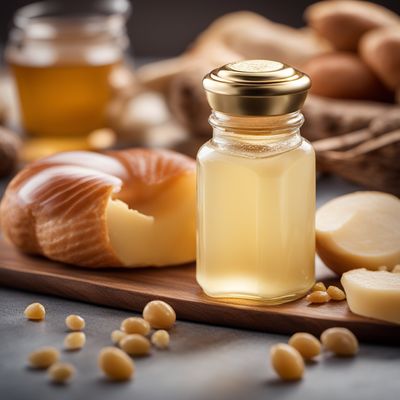
Ingredient
Turkey fat, processed
The Golden Elixir: Unveiling the Secrets of Processed Turkey Fat
Processed turkey fat is a rendered and refined form of fat obtained from turkeys. It is typically a pale yellow color with a smooth and creamy texture. This ingredient has a mild, savory flavor that enhances the taste of various dishes. It can be used for cooking, frying, or as a flavorful addition to sauces, gravies, and dressings. Its creamy consistency makes it easy to incorporate into recipes, providing a luscious mouthfeel and enhancing the overall flavor profile.
Origins and history
Turkey fat has been utilized in cooking for centuries, with its origins tracing back to the domestication of turkeys by Native Americans. It has played a significant role in traditional Thanksgiving feasts in the United States and has been a staple in various cuisines around the world. The rendering and processing of turkey fat have evolved over time, allowing for its preservation and widespread use in modern culinary practices.
Nutritional information
Processed turkey fat is a concentrated source of calories, providing approximately 120 calories per tablespoon. It is primarily composed of fat, with minimal amounts of protein and carbohydrates. While it is high in saturated fat, it also contains small amounts of monounsaturated and polyunsaturated fats.
Allergens
Processed turkey fat may contain traces of allergens such as soy, gluten, or dairy, depending on the processing methods and potential cross-contamination. Individuals with specific allergies should carefully check the product labels or consult with manufacturers.
How to select
When selecting processed turkey fat, opt for reputable brands that prioritize quality and transparency. Look for products that are free from additives, preservatives, and artificial flavors. Additionally, check the expiration date to ensure freshness.
Storage recommendations
To maintain the freshness and quality of processed turkey fat, store it in an airtight container in the refrigerator. It can be kept for several months when properly stored. Alternatively, it can be frozen for longer-term storage, ensuring it remains usable for up to a year.
How to produce
Producing processed turkey fat at home requires rendering the fat from turkey parts, such as skin or trimmings. This can be achieved by slowly heating the fat over low heat until it melts and separates from any solids. The liquid fat can then be strained and further refined through a filtering process to remove impurities.
Preparation tips
Processed turkey fat can be used as a cooking fat for sautéing, frying, or roasting, adding a delicious flavor to meats, vegetables, and grains. It can also be incorporated into sauces, gravies, or dressings to enhance their richness. When using processed turkey fat, it is important to consider its high smoke point, making it suitable for high-temperature cooking methods.
Culinary uses
Processed turkey fat is commonly used in traditional dishes such as Thanksgiving turkey, where it is used for basting and adding flavor to the bird. It is also a popular choice for frying or roasting potatoes, imparting a golden and crispy texture. Additionally, it can be used as a flavorful base for soups, stews, or sauces, enhancing their taste and richness.
Availability
Processed turkey fat is commonly available in regions where turkey is consumed, such as North America, Europe, and parts of Asia. It can be found in grocery stores, supermarkets, or specialty food stores.


